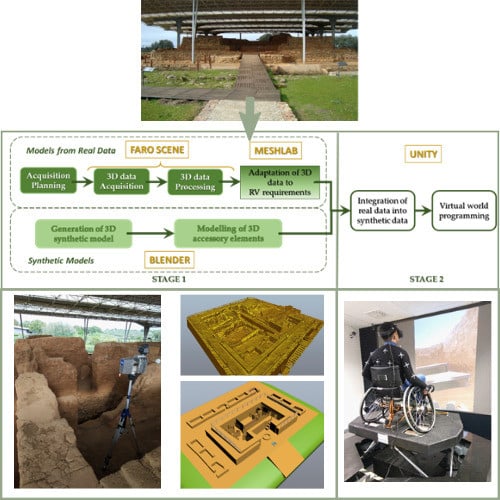Virtual Reality to Foster Social Integration by Allowing Wheelchair Users to Tour Complex Archaeological Sites Realistically
Abstract
1. Introduction
2. Materials and Methods
2.1. Cancho Roano Archaeological Site
2.2. The VR Experience Developed
2.2.1. Stage 1: Generation of the 3D Elements
- Models from Real Data
- Resolution lowering: the number of points must be reduced to obtain a model that can be represented in real-time on an average computer. This reduction is performed with the open-source 3D processing software Meshlab, which is well known and popular among the Computer Vision scientific community. Specifically, we applied the simplification “Quadric Edge Collapse Decimation” to the original point cloud of 25,000,000 points, resulting in a reduction of 14% data, that is, a point cloud with 3,500,000 points.
- Data type: the point cloud must become a triangular surface. To do this, all normals in the point cloud are first oriented using the "Compute normal" tool from the Meshlab software. A reconstruction process is then applied using the "Screened Poisson method”. The final triangular surface obtained consists of 6,800,000 triangles (Figure 4a).
- Synthetic Models
2.2.2. Stage 2: Virtual Reality System
- The main component of the VR system is the computer system, consisting of a workstation that enables the communication between all elements. The simulator management application has been developed in Unity, which allows the incorporation of models of virtual worlds and the possibility to interact with them. Besides, this software permits the administration of any hardware device that has the corresponding programming libraries, thanks to the possibility of introducing scripts in C# language. It is important to point out that the graphic power of this computer could limit the level of detail or complexity of the virtual worlds designed. In our case, it must manage several visualization outputs (those of the visualization systems) simultaneously, so it is necessary for the graphic card to have this functionality. Two graphics cards are used simultaneously in this simulator: Nvidia GTX970 and Nvidia Quadro K5200.
- The movements made by the user are caught by the motion capture systems: an optical system and a 5DT data glove. This system has a double purpose: to improve the users’ sense of immersion, as they can see their avatar moving in sync with the movements of their own body; and to register data for further analysis to diagnose possible problems or erroneous behavior. The data captured by the Optitrack’s system are transmitted in real-time to the virtual world avatar in Unity via its Motive software, which also allows the workspace to be calibrated and configured. The glove data is transmitted to Unity via its own scripts. Additionally, an inertial capture device can be used if necessary. This device captures the user’s movements in an autonomous manner, without the need for external cameras.
- The visualization systems offer two alternatives to display the virtual world, which can be used in different evaluation configurations. The first one consists of a large 3D screen (100 inches), on which to project the virtual world, and a set of active glasses, which provide the 3D immersion. This kind of representation allows both the user and the technical team to jointly observe the users’ interactions with the virtual world. The second visualization subsystem is a VR headset, which is operated exclusively by the user.
- The physical systems are a wheelchair, a motion platform, and an elevator system to access this platform. One of the most important and innovative parts of the developed system is a six-degree motion platform containing the wheelchair. It allows the users to simultaneously transmit the acceleration to which they are subjected as a response to the movements that take place in the virtual world, and to reproduce the different inclines of the terrain in the virtual world in which they are moving. The entire platform can change its orientation by means of a haptic system composed of two motor-driven active cylinders acting as an interface with the wheelchair, which must be positioned so that the wheels are in permanent contact with the cylinders. They have a dual function: on the one hand, they are activated when the user moves the wheels and detects the intention of the user’s movement. In addition, they emulate the ground conditions of the virtual world with the movement of the rollers: depending on the inclination and type of surface of the virtual world in which the users are located, they may feel more or less comfortable when moving the wheels. The movement of the rollers is measured and processed at the workstation, which also generates the rotation of the rollers corresponding to the movements of the wheels of the virtual wheelchair. Figure 6 shows the details of these components.
3. Results
3.1. Integration of the Motion Platform.
3.2. VR Application Development: Initial Synthetic Model and Design of Accessory Elements.
3.3. Integration with 3D Data: Visiting the Digitized Site.
4. Discussion
5. Conclusions
Author Contributions
Funding
Acknowledgments
Conflicts of Interest
References
- Gharebaghi, A.; Mostafavi, M.-A.; Chavoshi, S.H.; Edwards, G.; Fougeyrollas, P. The Role of Social Factors in the Accessibility of Urban Areas for People with Motor Disabilities. ISPRS Int. J. Geo Inf. 2018, 7, 131. [Google Scholar] [CrossRef]
- Luc, N.; Edwards, G.; Boucher, N.; Routhier, F.; Vincent, C.; Gascon, H.; Fougeyrollas, P. Enhancing Independent Community Access and Participation: Services, Technologies, and Policies. In Oxford Textbook Neurorehabilitation; Oxford University Press: Oxford, UK, 2015; pp. 399–417. [Google Scholar]
- UN. Defending. In General Assembly; United Nations: New York, NY, USA, 2006. [Google Scholar]
- Grilli, E.; Remondino, F. Classification of 3D Digital Heritage. Remote Sens. 2019, 11, 847. [Google Scholar] [CrossRef]
- Pithon, T.; Weiss, T.; Richir, S.; Klinger, E. Wheelchair simulators: A review. Technol. Disabil. 2009, 21, 1–10. [Google Scholar] [CrossRef]
- Abellard, P.; Randria, I.; Abellard, A.; Ben Khelifa, M.M.; Ramanantsizehena, P. Electric Wheelchair Navigation Simulators: Why, When, How. In Mechatronic Systems Applications; Di Paola, A.M.D., Cicirelli, G., Eds.; IntechOpen: Rijeka, Croatia, 2010; pp. 161–186. [Google Scholar]
- Mahajan, H.P.; Dicianno, B.E.; Cooper, R.A.; Ding, D. Assessment of wheelchair driving performance in a virtual reality-based simulator. J. Spinal Cord Med. 2013, 36, 322–332. [Google Scholar] [CrossRef]
- John, N.W.; Pop, S.R.; Day, T.W.; Ritsos, P.D.; Headleand, C.J. The Implementation and Validation of a Virtual Environment for Training Powered Wheelchair Manoeuvres. IEEE Trans. Vis. Comput. Graph. 2018, 24, 1867–1878. [Google Scholar] [CrossRef]
- Fernández-Panadero, C.; Cruz, V.; Morán, D.; Delgado, C. PhyMEL-WS Weelchair Simulator: A Preliminary Study to Increase Awareness about the Problems of Living the City in a Wheelchair. In Proceedings of the 3rd European Immersive Education Summit, London, UK, 28–29 November 2013; pp. 210–221. [Google Scholar]
- Fernández-Panadero, C.; Cruz, V.; Morán, D.; Delgado, C. PhyMEL-WS: Physically Experiencing the Virtual World. Insights into Mixed Reality and Flow State on Board a Wheelchair Simulator. J. Univers. Comput. Sci. 2014, 20, 1629–1648. [Google Scholar]
- Devigne, L.; Babel, M.; Nouviale, F.; Narayanan, V.; Pasteau, F.; Gallien, P. Design of an immersive simulator for assisted power wheelchair driving. In Proceedings of the 15th IEEE International Conference on Rehabilitation Robotics, ICORR’17, London, UK, 17–20 July 2017; pp. 995–1000. [Google Scholar]
- Pinheiro, O.R.; Alves, L.R.G.; Romero, M.F.M.; de Souza, J.R. Wheelchair simulator game for training people with severe disabilities. In Proceedings of the 1st International Conference on Technology and Innovation in Sports, Health and Wellbeing (TISHW), Vila Real, Portugal, 1–3 December 2016; pp. 1–8. [Google Scholar]
- Tao, G.; Archambault, P.S. Powered wheelchair simulator development: Implementing combined navigation-reaching tasks with a 3D hand motion controller. J. Neuroeng. Rehabil. 2016, 13, 3. [Google Scholar] [CrossRef] [PubMed]
- Alshaer, A.; Regenbrecht, H.; O’Hare, D. Immersion factors affecting perception and behaviour in a virtual reality power wheelchair simulator. Appl. Ergon. 2017, 58, 1–12. [Google Scholar] [CrossRef] [PubMed]
- Mortara, M.; Catalano, C.E.; Bellotti, F.; Fiuccy, G.; Houri-Panchetti, M.; Petridis, P. Learning cultural heritage by serious games. J. Cult. Herit. 2014, 15, 318–325. [Google Scholar] [CrossRef]
- Valtolina, S.; Franzoni, S.; Mazzoleni, P.; Bertino, E. Dissemination of Cultural Heritage Content through Virtual Reality and Multimedia Techniques: A Case Study. In Proceedings of the 11th International Multimedia Modelling Conference, Melbourne, Australia, 12–14 January 2005; pp. 214–221. [Google Scholar]
- Christofi, M.; Kyrlitsias, C.; Michael-Grigoriou, D.; Anastasiadou, Z.; Michaelidou, M.; Papamichael, I.; Pieri, K. A Tour in the Archaeological Site of Choirokoitia Using Virtual Reality: A Learning Performance and Interest Generation Assessment. In Advances in Digital Cultural Heritage; Ioannides, M., Martins, J., Žarnić, R., Lim, V., Eds.; Lecture Notes in Computer Science: Berlin, Germany, 2018; Volume 10754, pp. 208–217. [Google Scholar]
- Pérez, E.; Merchán, M.J.; Moreno, M.D.; Merchán, S.; Salamanca, S. Touring the Forum Adiectum of Augusta Emerita in a Virtual Reality Experience. In Digital Heritage. Progress in Cultural Heritage: Documentation, Preservation, and Protection; Ioannides, M., Ed.; Lecture Notes in Computer Science: Berlin, Germany, 2018; Volume 11196, pp. 548–559. [Google Scholar]
- Celestino, S.; Jiménez, J. El Palacio-Santuario De Cancho Roano IV, El Sector Norte; Bartolomé Gil Santacruz: Badajoz, Spain, 1993. [Google Scholar]
- Jiménez, J. Cancho Roano: Más que palabras. In Bibliografía Crítica Sobre El Yacimiento Post-Orientalizante De Zalamea De La Serena; Diputación Provincial de Badajoz: Badajoz, Spain, 2013. [Google Scholar]
- Celestino, S. Arqueología Protohistórica De La Serena. Cuad. Prehist. Arqueol. 2011, 38, 297–305. [Google Scholar] [CrossRef][Green Version]
- Celestino, S. Cancho Roano; CSIC: Madrid, Spain, 2001. [Google Scholar]
- Jia, F.; Lichti, D.D. A Model-Based Design System for Terrestrial Laser Scanning Networks in Complex Sites. Remote Sens. 2019, 11, 1749. [Google Scholar] [CrossRef]
- Balta, H.; Velagic, J.; Bosschaerts, W.; De Cubber, G.; Siciliano, B. Fast Statistical Outlier Removal Based Method for Large 3D Point Clouds of Outdoor Environments. IFAC Pap. 2018, 51, 348–353. [Google Scholar] [CrossRef]
- Merchán, P.; Adán, A.; Salamanca, S.; Domínguez, V.; Chacón, R. Geometric and Colour Data Fusion for Outdoor 3D Models. Sensors 2012, 12, 6893–6919. [Google Scholar] [CrossRef] [PubMed]
- EU Committee of the Regions. Towards an Integrated Approach to Cultural Heritage for Europe; EDUC-V/046; European Union Committee of the Regions: Brussels, Belgium, 2015. [Google Scholar]
- Deffner, A.; Psatha, E.; Bogiantzidis, N.; Mantas, N.; Vlachaki, E.; Ntaflouka, P. Accessibility to Culture and Heritage: Designing for All. In Proceedings of the AESOP 2015, ‘Definite space—Fuzzy responsibility’, Prague, Czech Republic, 13–16 July 2015. [Google Scholar]
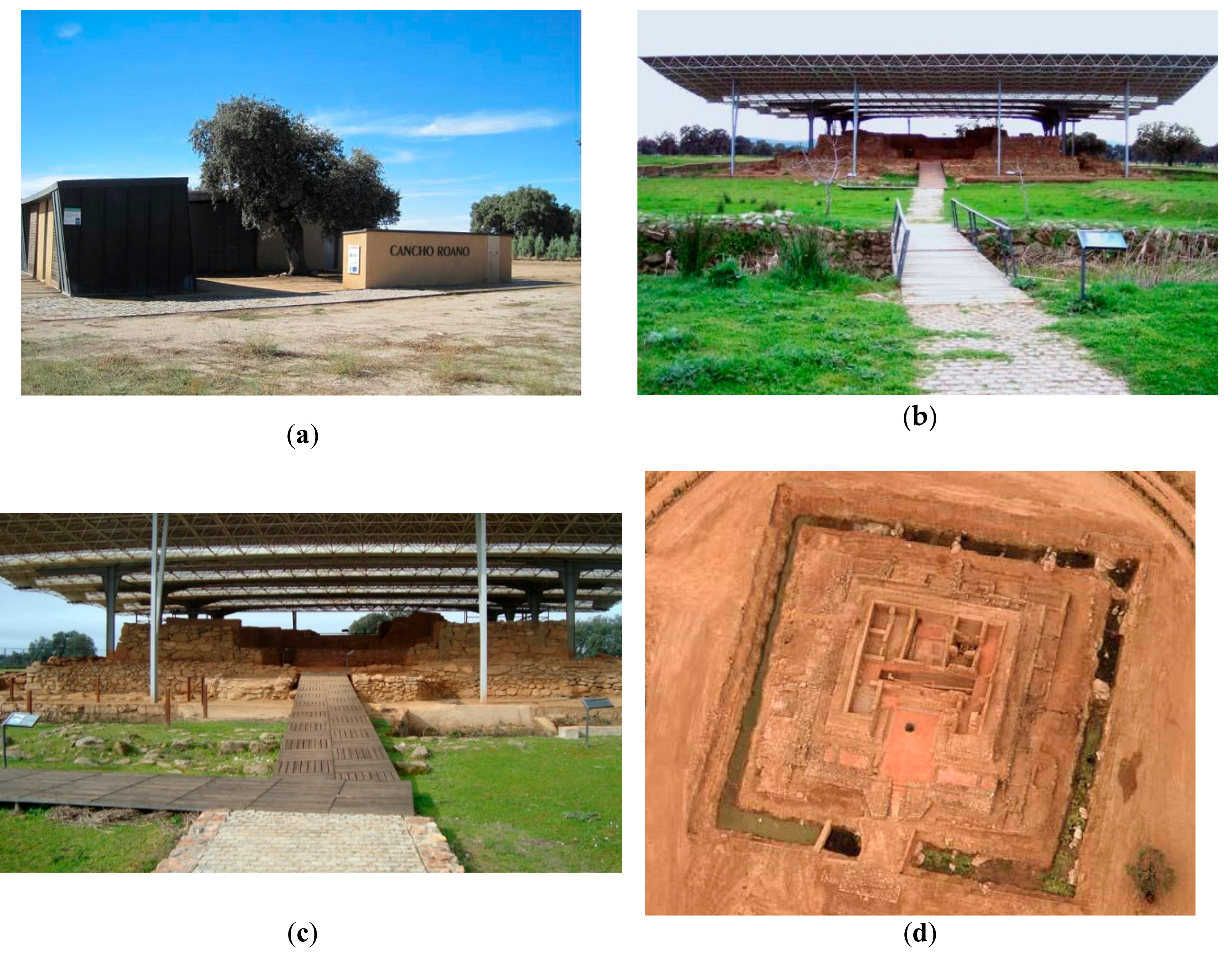

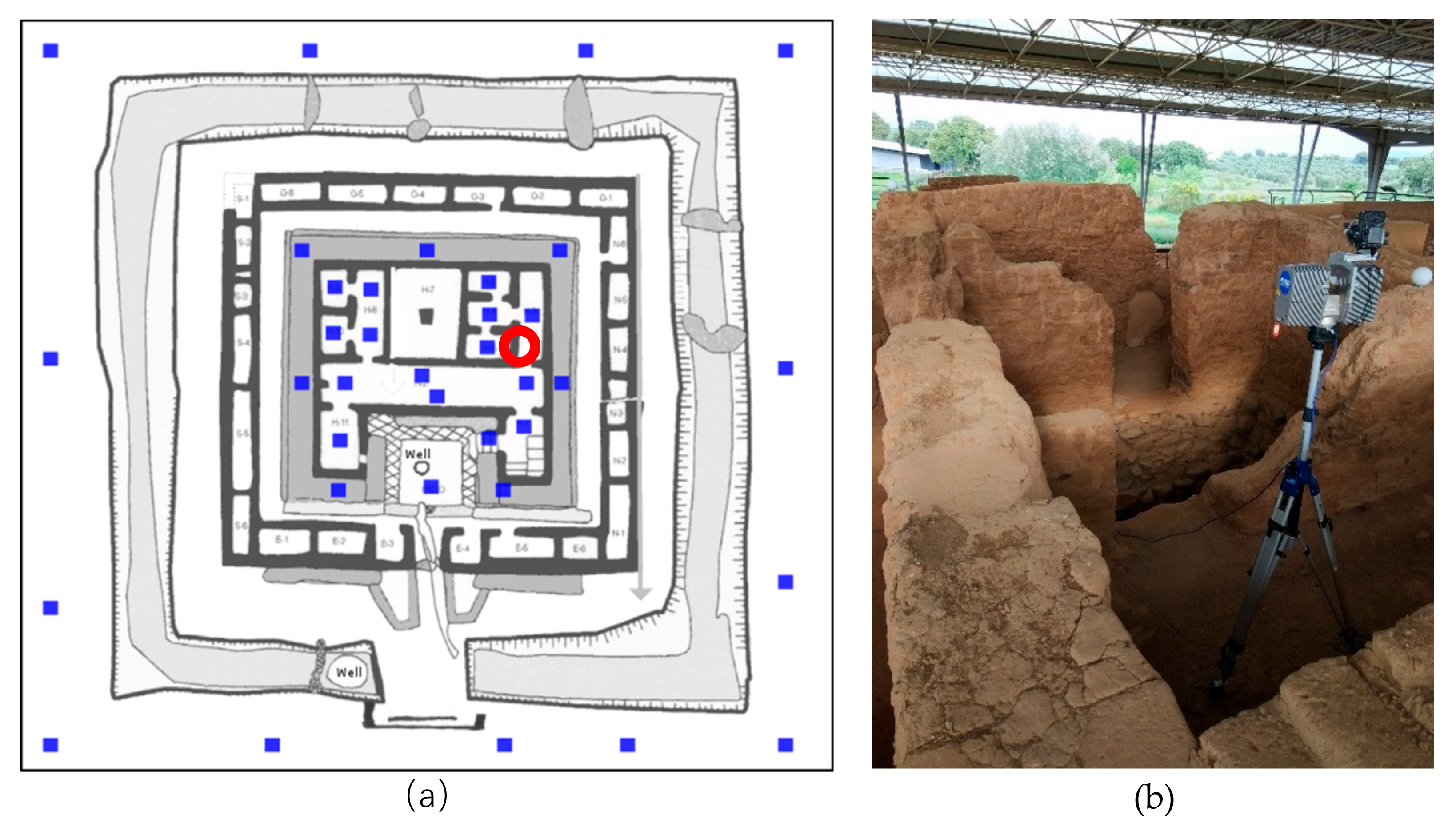

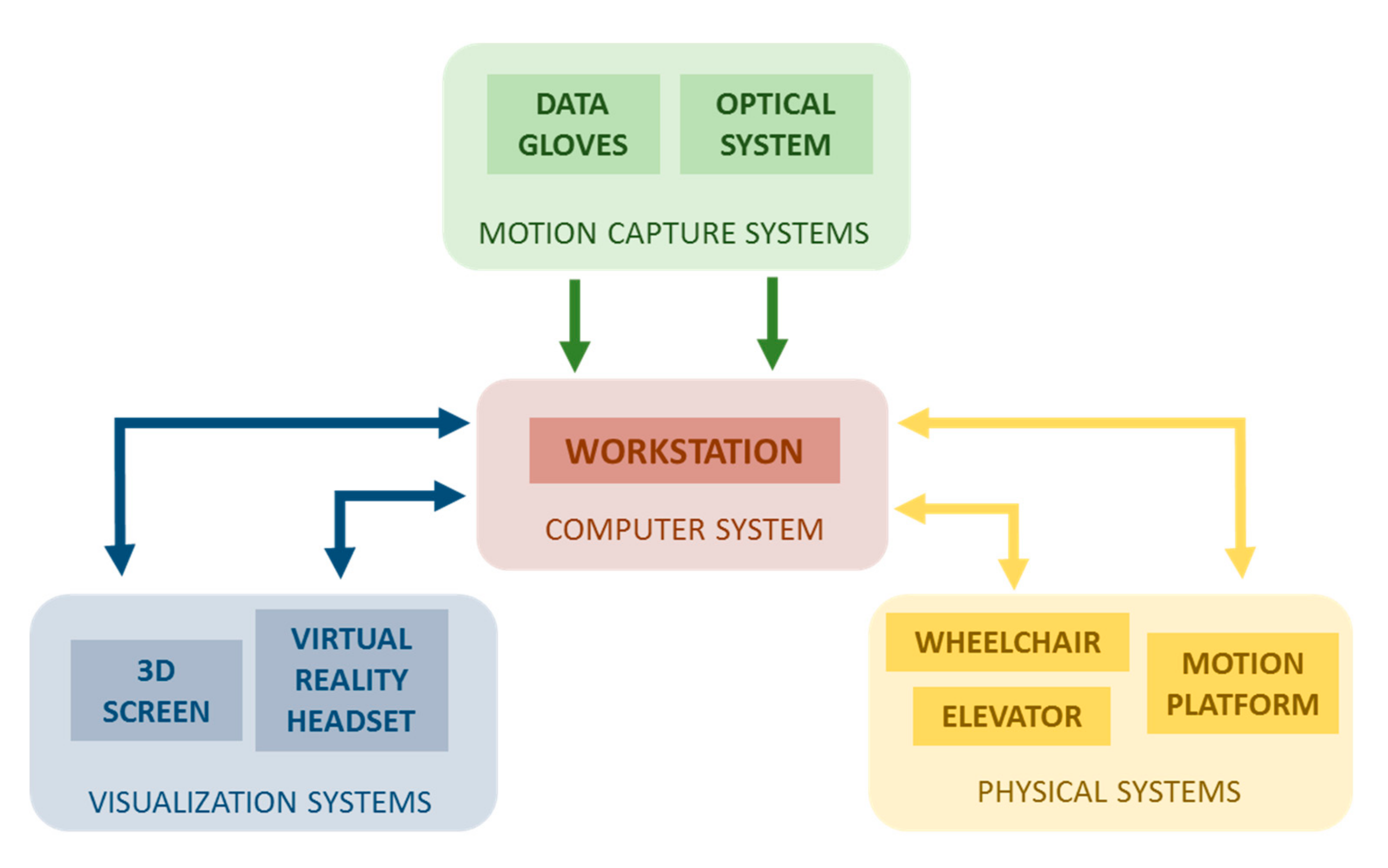


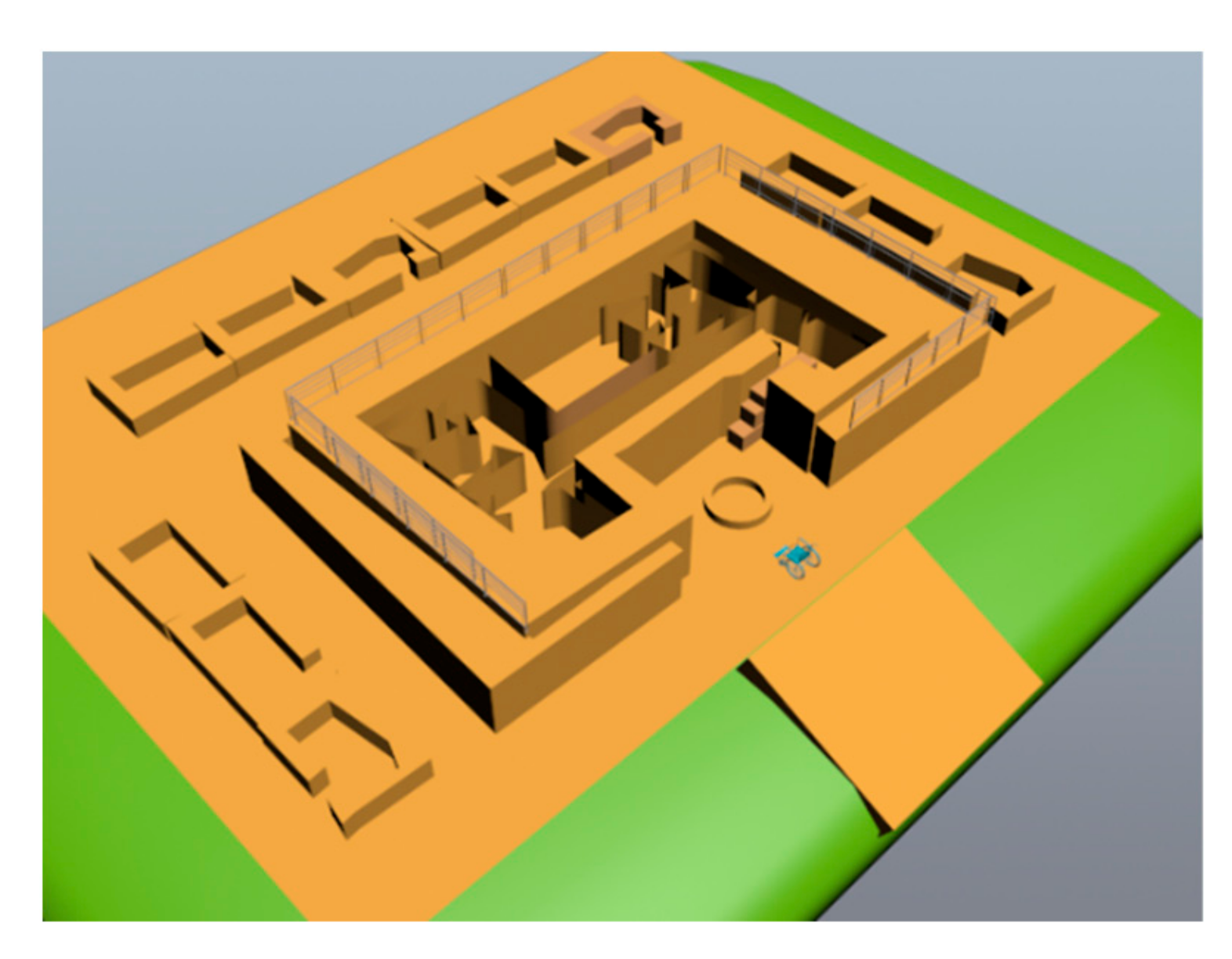
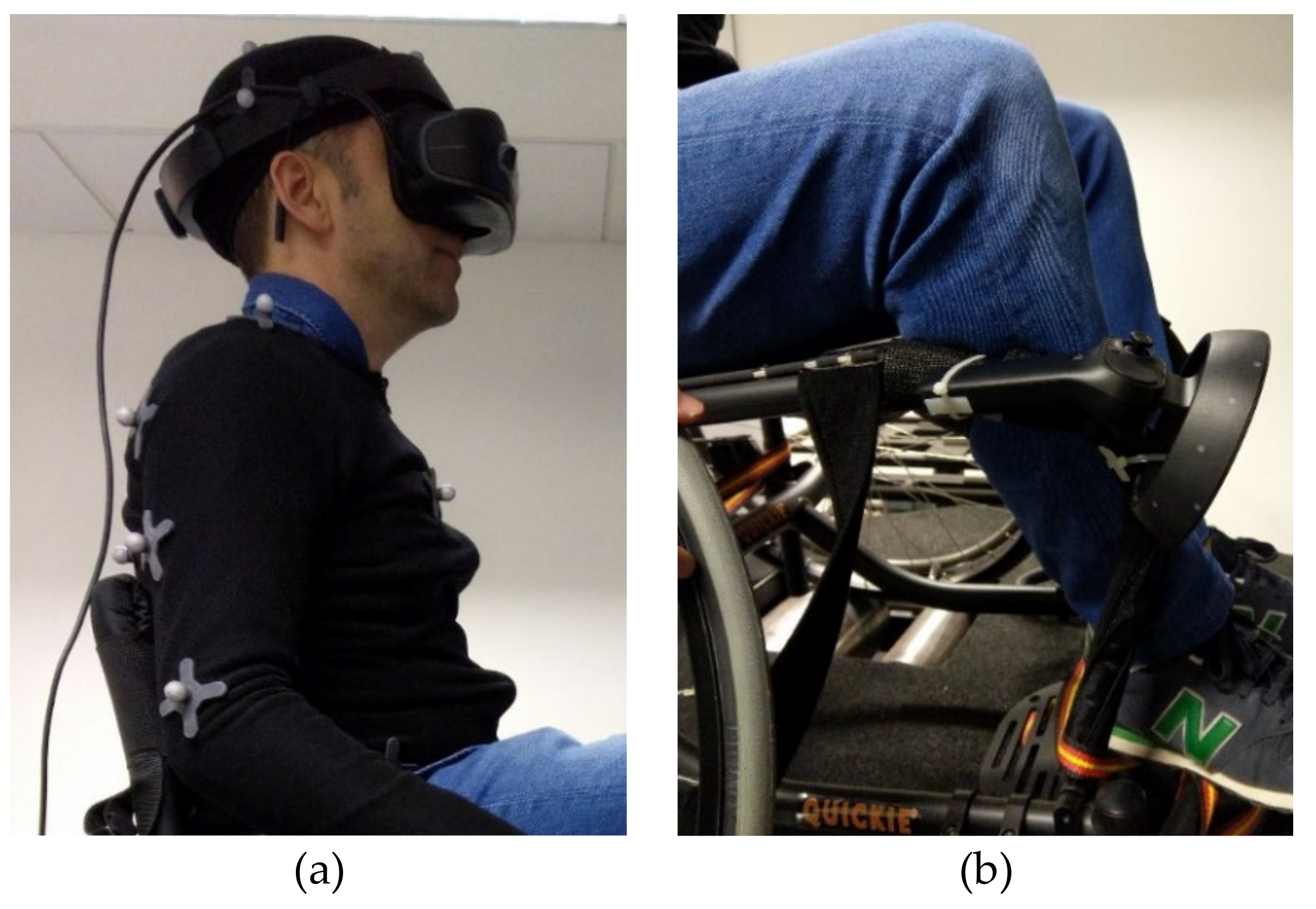

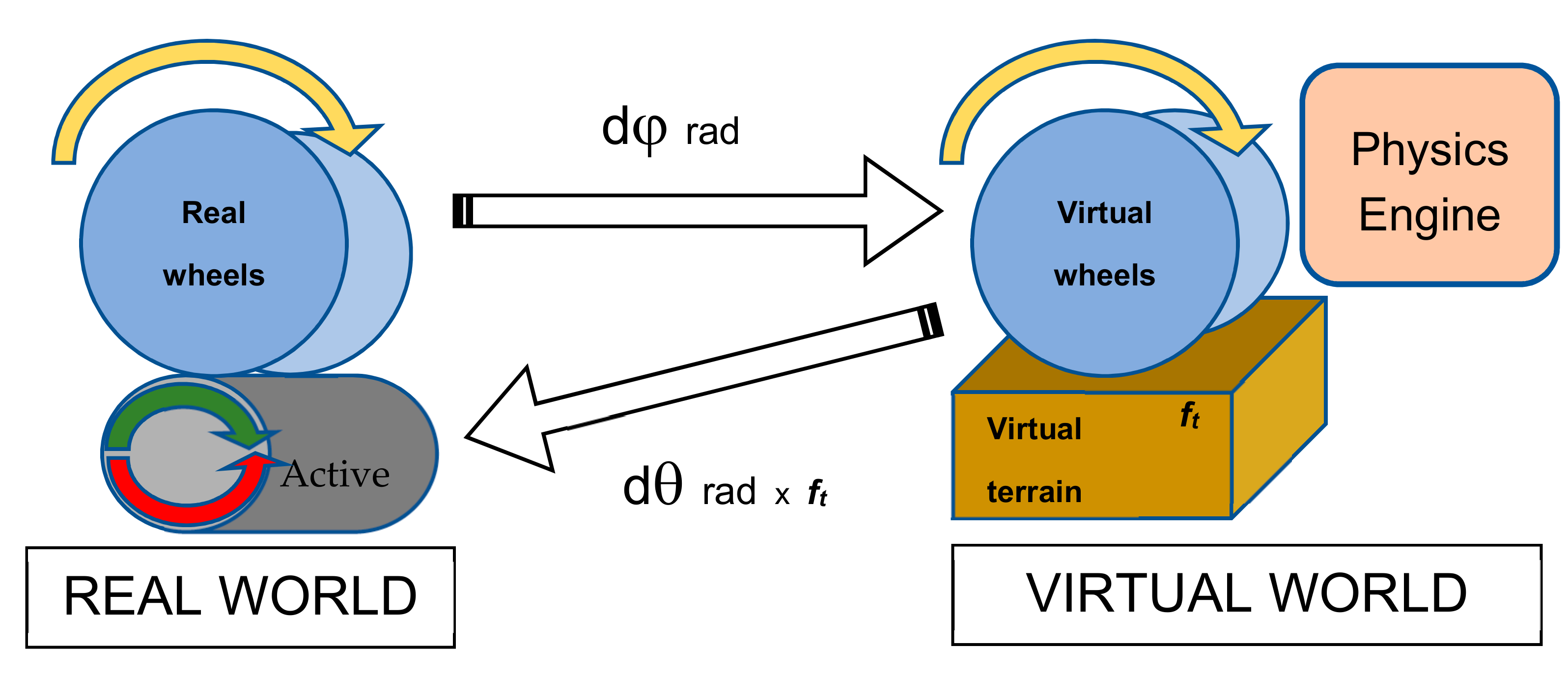
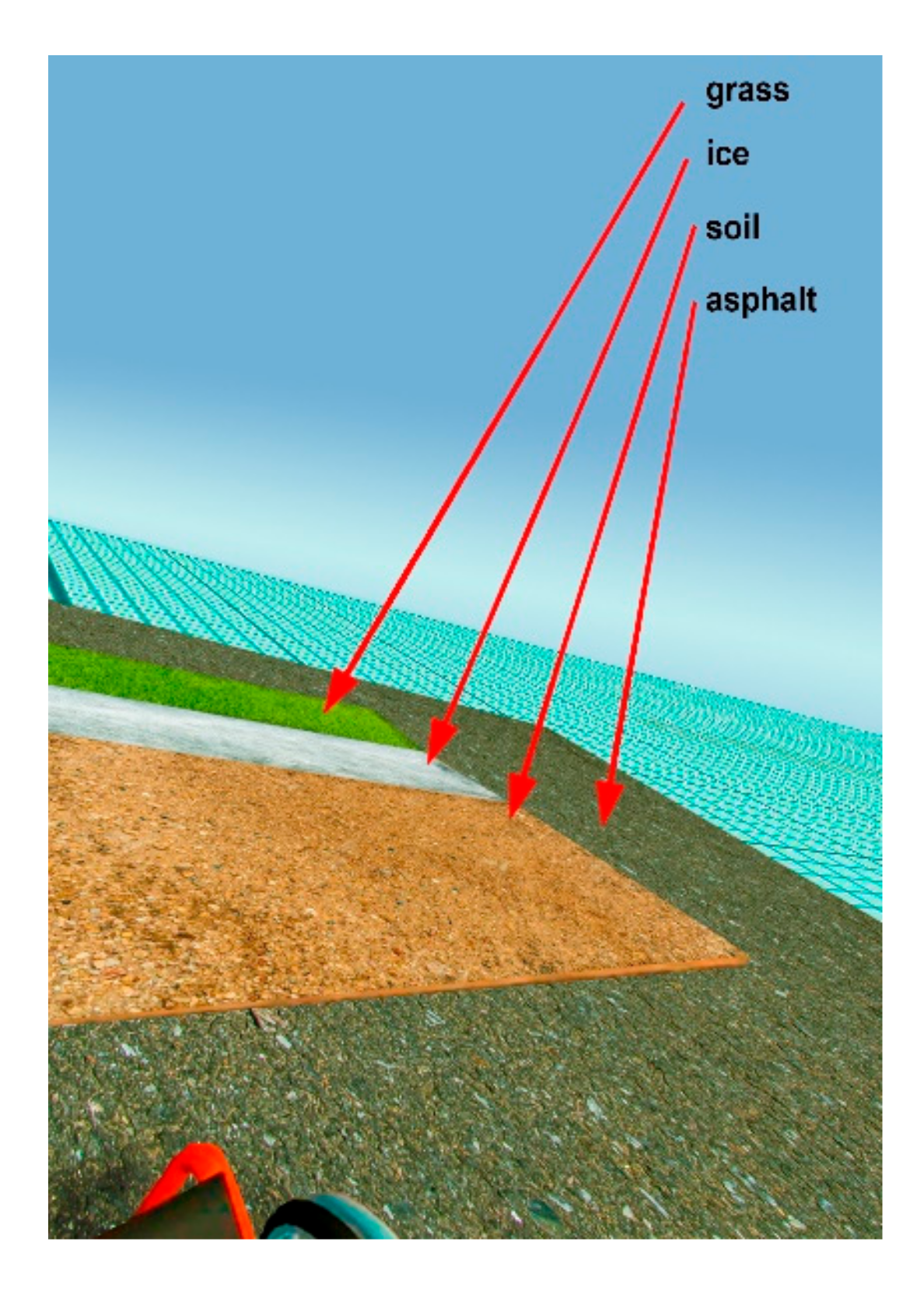
© 2020 by the authors. Licensee MDPI, Basel, Switzerland. This article is an open access article distributed under the terms and conditions of the Creative Commons Attribution (CC BY) license (http://creativecommons.org/licenses/by/4.0/).
Share and Cite
Pérez, E.; Merchán, P.; Merchán, M.J.; Salamanca, S. Virtual Reality to Foster Social Integration by Allowing Wheelchair Users to Tour Complex Archaeological Sites Realistically. Remote Sens. 2020, 12, 419. https://doi.org/10.3390/rs12030419
Pérez E, Merchán P, Merchán MJ, Salamanca S. Virtual Reality to Foster Social Integration by Allowing Wheelchair Users to Tour Complex Archaeological Sites Realistically. Remote Sensing. 2020; 12(3):419. https://doi.org/10.3390/rs12030419
Chicago/Turabian StylePérez, Emiliano, Pilar Merchán, María José Merchán, and Santiago Salamanca. 2020. "Virtual Reality to Foster Social Integration by Allowing Wheelchair Users to Tour Complex Archaeological Sites Realistically" Remote Sensing 12, no. 3: 419. https://doi.org/10.3390/rs12030419
APA StylePérez, E., Merchán, P., Merchán, M. J., & Salamanca, S. (2020). Virtual Reality to Foster Social Integration by Allowing Wheelchair Users to Tour Complex Archaeological Sites Realistically. Remote Sensing, 12(3), 419. https://doi.org/10.3390/rs12030419







